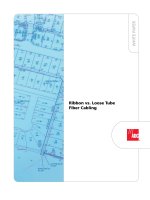Tài liệu Presentation - Tek Trend - IBMS & Structured Cabling System for Intelligent Bldg doc
Bạn đang xem bản rút gọn của tài liệu. Xem và tải ngay bản đầy đủ của tài liệu tại đây (3.6 MB, 82 trang )
Intelligent Building
&
Structured Cabling System
Đặng Thạch Quân
Managing Director
Quang Dung Technology Trading Co.
Agenda
1. Intelligent Building Overview
2. IBMS & Network
3. NEXT GENERATION Structured Cabling System
4. ADC KRONE TrueNet
®
Solution
What is Intelligent Building?
True Intelligent building is a better building that uses
less energy, lower operating expenses, provides a
comfortable, secure, efficient, productive environment
and experience for all – while increasing the value and
marketability for the owner.
”Use of technology and process to create a building
that is safer and more productive for its occupants
and more operationally efficient for its owners.”
Paul Ehrlich
Founder and President
Building Intelligence Group
Why Intelligent Building?
1. Save ELECTRICITY =>avg. 20%
– Singapore IBMS 2005 Survey result:
• Building with IBMS: Avg. 125,6 KW/m
2
/yr
• Building without IBMS: Avg. 356 KW/m
2
/yr
2. Save TIME
3. Save HUMAN RESOURCE
4. Reduce ERRORS
5. Improve SAFETY
Building & IBMS
IBMS: Intelligent Building Management System
allows Real-time management of the Building environment from
single point. Services include:
1. Voice & Sound (PABX, Public Address System…)
2. Data (LAN, SAN, Intranet…)
3. Video & Images (IP Surveillance, Camera, TV, Satellites)
4. HV Air Condition (Air, Temperature, No. of ppl…)
5. Identification & Authentication (Card, Biometric scan…)
6. Electricity & Water (UPS, Generator, Water treatment…)
7. Alarm systems (Fire & Smoke, Liquid detection…)
8. Lighting (Indoor, outdoor, Emergency…)
9. Document delivering (Documents, money…)
10. Lifts & Transportation
11. Car parking (Driver identification, Security check…)
12. …
Building Management System
An Intelligent Building has thousands of pieces of data available.
Tools will be needed to evaluate, and prioritize, presenting only
the required information to the IBMS operator.
• Building Management Tools
– Complete Integration
– Tenant Portals
– System Dashboards
– Next Generation Maintenance Management Programs
– Enterprise Energy Management
– Operating Staff Efficiency
– Mobile Operations
– Centralized Operations Center
Intelligent Building & Technology
• Technology - General
– Tenant amenities (concierge, visitor management,
shopping, restaurants, lodging, parking, restrooms)
– Optimized vertical transport
– Personal comfort control (temperature, humidity, IAQ,
lighting, acoustic)
• Technology - Security / Life Safety
– Digital video monitoring
– Access control and monitoring
– Automatic fire suppression
– Fire detection and alarm
– Egress support (lighting, signage, smoke control, etc.)
– Contaminant monitoring and containment
– Proximate security / guard services
Intelligent Building & Technology
• Technology - Networking / Telecom
– Common network infrastructure
– Structured cabling system
– Wi-Fi & VoIP
– Digital signage
• Technology - Mechanical
– Energy efficient equipment
– Thermal storage
– Combined heat and power
– Controls optimization (extensive sensing, energy efficiency, indoor air
quality, comfort monitoring, Internet enabled controls, enterprise
integration, water, and gas metering / sub-metering)
•
Technology - Electrical
– Energy efficient lighting
– Lighting control
– Distributed generation
– Dual power feeds / emergency power
– Power quality monitoring
– Sub-metering / billing
Market Trend
• Intelligent buildings can be built with today’s state-of-
the-art technology if owners understand the building’s
value and are sufficiently organized and prepared to
implement it. The ultimate challenge is to seize the
opportunity to build a more efficient, cost-effective and
value-enhanced buildings that attract tenants.
• The market demand for high performance building is
growing because they attract investments, reduce
energy costs, improve productivity, extend a building’s
life cycle and decrease financial risk, thus providing a
higher financial return.
Intelligent Buildings
Market Size
• The 1999 CBECS estimated that 4.7 million commercial buildings were
present in the U.S. that year.
• Those buildings comprised a total of 67.3 billion square feet of floor
space with the average size for all commercial buildings in 1999 being
14,460 square feet.
• Half of all the commercial buildings were in the smallest size category
(1,001 - 5,000 ft²) with another 24% in the next larger category
(5,001 - 10,000 ft²). The largest size category - buildings larger than
500,000 ft² - was comprised of only 7,000 commercial buildings.
• Lastly, the median age for all commercial buildings in 1999 was 30.5
years with more than 36% of buildings constructed prior to 1960.
• The market of Automation and Control of Building utilities is a market
worth some $11 billion*
• It is growing on average by more than 6% a year*
* Schneider Electric estimate
Implications for the Future
• Looking back at history we can make the following
conclusions:
– Over the past 30 years speed and bandwidth requirements
from new applications and software have driven advancements
in hardware and structured cabling bandwidth
• Example: 1994-1995 – Netscape → Windows 95 → IE → Real
Audio and Java Script → 100Base-TX → Cat 5 Cabling (65% share)
– Technology developments accelerate with time
– Today’s technology will not support 2010’s requirements
• Example: Typical 1990 PC was a 386 running Windows 3.0, would
this support the applications of 1995?
– Today’s technology is driving us beyond Gigabit
Who should consider?
• Essential consideration for senior managers and decision
makers involved in the design, construction and
management of commercial buildings, including:
– Architects
– Building Systems Designers, Specifiers & Suppliers
– Property and Real Estate Investors & Developers
– Operating Engineers
– Property Managers
– IT Managers
– Facility, Environmental & Energy Managers
– Consulting Engineers
– System Integrators
– Mechanical and Electrical Contractors/Engineers
– System Manufacturers
IBMS & Network
for Intelligent Building
IBMS Protocols
• Current Building Management Systems are
proprietary networks
• 47 separate proprietary protocols (US 2004
survey)
• No Standard available as of today
When devices speak different languages
Building Control Systems
Security Devices
HVAC,
Power and
Lighting
Manufacturing
IBMS Protocols & Standards
• IP over Ethernet is an open, inexpensive
way to connect many of these systems.
• Many BAS vendors are embracing IP Ethernet –
Honeywell, Johnson Controls, Siemens …
• Open standards are at the heart of enabling the
intelligent building inter-operablity
– BACnet (Building Automation Control Network)
– OPC
– LonTalk
– oBIX (open Building Information Xchange)
– Modbus
– and other protocols used to enable integration.
Today’s Emerging Applications
• RFID – Radio Frequency Identification
• Intelligent Buildings – Now a reality
with integration of Power over Ethernet
• Industrial Ethernet –Large scale
replacement of 10/100Base-T controllers
in place of legacy RS232 and other
protocols
• Web Conferencing -WebEx, Net
Meeting, etc.
• Video over IP – Quality of service not
there yet, but is on the horizon, issues
include latency and bandwidth
• IPTV – Carriers on the offensive against
Cable TV and Satellite providers
BACnet™
• A Data Communication Protocol for Building
Automation and Control networks
• Benefits of this standard Protocol
– Single operator workstation for all systems
– Competitive system expansion
– Eliminates the fear of being ‘locked in’
– Possibility of integrating all Building Automation Control
(BAC) functions
– Interoperability
• Data Sharing
• Alarm and event management
• Trending
• Scheduling
• Remote device and network management
Commonality
All 1’s and 0’s
What do Building Control Systems, PLC, RFID, Email,
Digital Cellular and Storage Area Networks all have
in common?
10001011100101011100010101001110110101001
Preamble
8 bytes
Destination
6 bytes
Source
6 bytes
Type
2 bytes
Data
46-1500 bytes
CRC/FCS
5 Bytes
Ethernet Packet
Packets are just like letters
Preamble
8 bytes
Destination
6 bytes
Source
6 bytes
Type
2 bytes
Data
46-1500 bytes
CRC/FCS
5 Bytes
Ethernet Packet
Even in different languages
When devices speak a common language
Building Control Systems
Security Devices
HVAC,
Power and
Lighting
Manufacturing
Baseline IP
Bursty
VoIP
WAP
Security
Lighting
HVAC
Total IP Convergence









